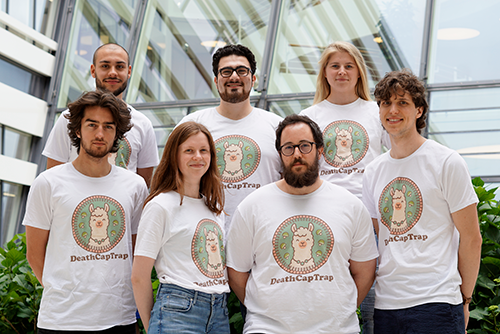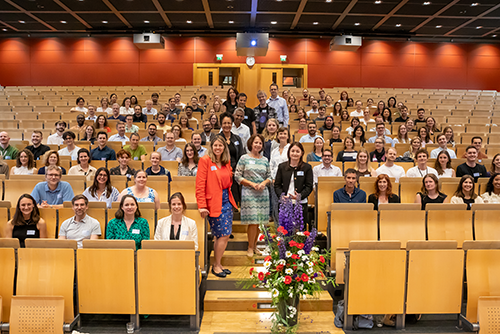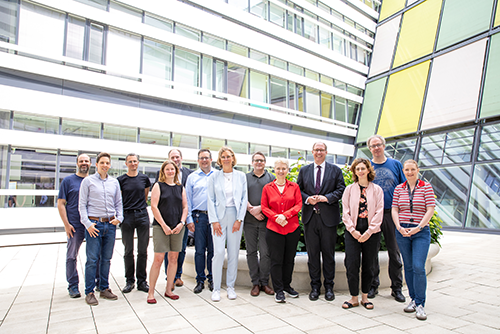New vulnerability discovered in hospital bacterium
Team of researchers identifies promising target for drug development
It is one of the most resistant pathogens in medicine: Pseudomonas aeruginosa defies many antibiotics, forms protective biofilms and survives even under conditions of severe stress. Now, an international team of researchers at the Centre for Structural Systems Biology (CSSB) on the DESY campus has discovered a promising vulnerability. In collaboration with researchers from England and the USA, the scientists have identified three enzymes that control key functions for stress tolerance and the formation of biofilms. In the future, these could be targeted by drugs, providing a new option for treating multiresistant infections.

The bacterium Pseudomonas aeruginosa belongs to a group of pathogens known by the acronym ESKAPE. These are responsible for numerous hospital-acquired infections and are highly resistant to antibiotics. Pseudomonas causes pneumonia, urinary tract infections and sepsis – especially in people with compromised immune systems or chronic diseases such as cystic fibrosis. What makes the bacterium particularly insidious is its ability to form biofilms on surfaces, such as catheters or implants. These slimy coatings encase and protect the pathogens, making them even more difficult to treat.
Successfully knocked out
The team of researchers led by Holger Sondermann and María Jesús García-García studied three genes whose function was previously unknown. “Pseudomonas has about 5000 to 6000 genes,” explains Sondermann. “But we only know the function of about two thirds of these genes.” To shed some light on the matter, the team specifically switched off the genes of interest – and observed some significant changes. Mutants lacking the three genes failed to grow under osmotic stress, formed less stable biofilms and were more sensitive to common antibiotics.
However, simply switching off individual genes was not enough. Only when all three genes were knocked out at the same time did this have a clear impact on the behaviour of Pseudomonas aeruginosa. “The enzymes in the bacterium are redundant,” explains María Jesús García-García. “They can stand in for each other, so knocking out a single gene has no effect.”
The team also succeeded in working out the three-dimensional structure of the newly discovered enzymes using X-ray crystallography. They discovered an astonishing parallelism: the structure of the enzymes is similar to that of HIV protease, an important target for AIDS drugs. “This came as a surprise,” says Holger Sondermann. “We were able to show that bacteria have enzymes whose structure is similar to that of HIV protease.” However, their functions are different: HIV protease is an enzyme that chops long protein chains into functional pieces, which is what allows the HIV virus to multiply. The three newly discovered bacterial enzymes are also proteases – biomolecules that cleave other proteins – but it is still unclear which molecules the Pseudomonas enzymes target.
Doubling the odds
The three enzymes could be promising targets for medical interventions. On the one hand, knocking them out ought to make Pseudomonas more sensitive to antibiotics to which the bacterium is normally resistant. On the other hand, the loss of these enzymes would impair the pathogen’s ability to form stable biofilms – giving potential treatments a significant advantage. “We may not need entirely new antibiotics after all,” explains María Jesús García-García. “It might be enough to enhance the effect of existing antibiotics by specifically inhibiting these enzymes.”
But a number of questions still need to be answered before that can happen. It is not yet clear which protein molecules the newly discovered proteases cleave in the bacterium. Initial evidence suggests that they cleave so-called polyglutamate sequences. Whether such polymers actually occur in Pseudomonas or whether they are only produced in specific situations of stress is currently being investigated. “Our next step is to identify the natural targets of these enzymes,” says García-García. “Understanding their biological function is crucial in order to avoid possible side effects in future therapies.”
At the same time, the team is planning to test the first inhibitors. Since the enzymes are found in key pathogens such as Pseudomonas and Legionella but rarely in beneficial intestinal bacteria, specific drugs could target the harmful bacteria without severely impacting the microbiome. Despite the promising results, the team remains realistic: “Developing new drugs is a long process,” Holger Sondermann points out. “But we are cautiously optimistic that these enzymes could be an interesting new target – similar to HIV protease in the treatment of AIDS.”
Reference:
Justin D. Lormand, Charles H. Savelle, Jennifer K. Teschler, Eva López, Richard H. Little, Jacob G. Malone, Fitnat H. Yildiz, María J. García-García, Holger Sondermann: Secreted retropepsin-like enzymes are essential for stress tolerance and biofilm formation in Pseudomonas aeruginosa. https://journals.asm.org/doi/10.1128/mbio.00872-25



